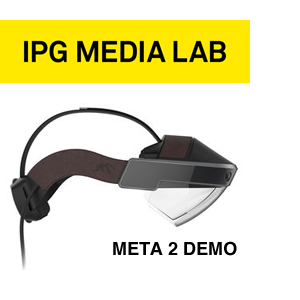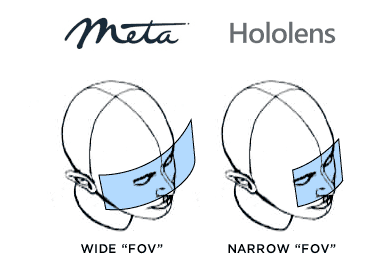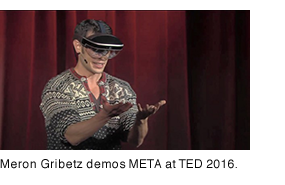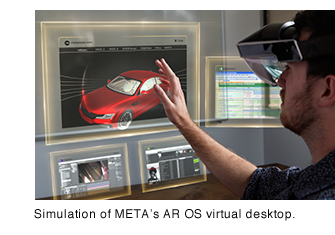META – The Contender
 Friday, August 12, 2016 at 9:11PM
Friday, August 12, 2016 at 9:11PM 
It was with great anticipation that I finally demoed the META 2 glasses, shortly before departing New York. Co-Founder and CEO, Meron Gribetz was a student of Steve Feiner — Computer Science professor who runs the AR/VR lab at Columbia University, and one of the earliest pioneers in the AR space, as well as one of my own personal inspirations. Feiner now serves as scientific advisor to META. Co-Founder and CTO, Raymond Lo received his PhD studying under another pioneer and hero of mine, professor Steve Mann of the University of Toronto, a once founding member of the Wearable Computing group at MIT under Nicholas Negroponte, who also serves as META’s Chief Scientist. I don’t personally know Meron or Raymond, though I know both of their mentors, and Feiner in particular I’ve known for many years. In 2013 I attended META’s launch party during Augmented World Expo. I’ve enthusiastically supported their progress in the space for years.
Having reviewed HoloLens last year, I was eager to see how META compared.
 A few weeks ago I received an invitation to demo META 2 glasses at the IPG Media Lab in New York. I had not been in the 100 West 33rd St. building since servicing the Hewlett Packard and Verizon advertising accounts during my time at FCB. All around, I was excited to be invited as well as to see my old office.
A few weeks ago I received an invitation to demo META 2 glasses at the IPG Media Lab in New York. I had not been in the 100 West 33rd St. building since servicing the Hewlett Packard and Verizon advertising accounts during my time at FCB. All around, I was excited to be invited as well as to see my old office.
META was running slightly behind, and I volunteered to let a couple of others skip in front of me who were on tighter schedules, before eventually getting my turn. I would prefer to wait, and not have my demo rushed.
Once called on, I entered the demo space and was fitted with the META 2 headset — I knew immediately that this demo would be very different than the HoloLens demo from the previous year. Perhaps an unfair comparison, given Microsoft’s virtually limitless funds — it has been willing to pay whatever it takes to get ahead in this category. In 2014 Microsoft paid more than twice as much to acquire ODG’s IP portfolio than all the money META has raised to date. Rumor has it Microsoft may have already put over $1B into HoloLens development. Unfair comparisons aside, META will be competing head-to-head with Microsoft, as well as with MagicLeap, the secretive AR headset developer that has raised over $1B, led by Google Ventures. Given the deep pockets of their competition, META has gotten very far on their $73M.
HoloLens’ demo was slick as spit, running three simultaneous demo rooms, and three backup units on the shelf per room, conversely META showed up at the Media Lab with exactly 1 demo unit (a bit bulkier than a HoloLens), with the head-strap showing visible wear.
Let’s get some of the bad out of the way: META requires a tether. A heavy cable attaches the device to a laptop. Further, in addition to the sensors on the headset itself, off-board sensors are required: a camera / depth-sensor device that resembles a giant kinect unit, placed 7 or 8 feet in the air on a tripod, stands adjacent to the demo at all times.
 Why is META bogged down with laptops, tethered cables, and external sensors when HoloLens operates with the entire computer inside the device? The same reason that META has a 90° field-of-view and 2560x1440 resolution; and HoloLens has a 35° field-of-view and a resolution that Microsoft will not confirm (window-screen pixelation is visible on HoloLens) — Tradeoffs.
Why is META bogged down with laptops, tethered cables, and external sensors when HoloLens operates with the entire computer inside the device? The same reason that META has a 90° field-of-view and 2560x1440 resolution; and HoloLens has a 35° field-of-view and a resolution that Microsoft will not confirm (window-screen pixelation is visible on HoloLens) — Tradeoffs.
It is easy to liken this to the Betamax vs VHS battle (Betamax technically had better specs: better resolution, better sound quality … but could not fit a whole movie on one side of a tape. For readers under the age of 30: VHS won.).
But to be fair, these are both still pre-consumer / developer kit products. META outlined a roadmap to achieve an untethered device, first moving to a belt worn unit, “slightly larger than a smartphone” in 2017, and eventually to a fully internally contained computer by 2018. If this is true (still an “if”) there is nothing to say that Microsoft isn’t working from the opposite direction, pushing the resolution higher and the field-of-view wider with each successive iteration. In fact, it can safely be assumed that they are.
Working on a shoestring budget (all things being relative), META has developed a gorgeous display, higher resolution and wider in field-of-view than anyone else has demoed publicly to date. It was bright, solids had good opacity, and the virtual content smoothly alpha-channeled into the real world. I did not experience any eye-strain or fatigue.
The demo itself did leave a bit to be desired. The young marketing fellow running the demo was left to repeatedly apologize for various technical shortcomings and glitches. Some 3D video content was shown with genuine wow factor, as-well-as hand tracking for object manipulation (more on that later), but most of the demo focused on floating panels, flat planes displaying various Windows’ content. This was meant to show how META could replace large multi-screen flat-panel display configurations with a single device, however a technical malfunction left most of the panels at an awkward angle, the top tilted ~20° forward, instead of perpendicular to my field of view. At first the META marketing rep attempted to spin it as intentional (I wasn’t buying it and pressed further) before he conceded that he was aware of the issue but had nobody on-hand that could fix this calibration problem. I was kindly asked to understand that this was a “demo,” still in development. More than once the head-tracking failed and I was asked to not move my head around so quickly. Further, the minimal movement I did make required the device to once be re-fitted on my head — this is in stark contrast to HoloLens which demoed with a game requiring that I jump about ducking and weaving while dodging flying fireballs, and it never lost tracking nor lost its fitting.
 Further, the META 2’s hand-tracking also had problems. The external sensor on the tripod stand was blamed this time. The demo was momentarily suspended while a second demo operator came in and together they made adjustments to the external sensor before repeating part of my demo. I smiled patiently.
Further, the META 2’s hand-tracking also had problems. The external sensor on the tripod stand was blamed this time. The demo was momentarily suspended while a second demo operator came in and together they made adjustments to the external sensor before repeating part of my demo. I smiled patiently.
HoloLens has released some post-production created concept videos showing some complex hand-tracking capabilities similar to those sported by META, but the HoloLens demo recognized only a single “tap” in the air with the user’s index finger. Obviously Microsoft is doing these things in the lab, which would imply that they’re not yet confident enough in this feature to risk a public demo. In this regard META can be commended for taking the risk. When it worked properly, the effect (scaling, lifting and moving virtual objects by hand), was impressive.
A few days later I happened to run into Steve Feiner at a local AR Tech Meetup (ARNY) and we conversed some about my META demo experience. I did not ask him to go on the record so I will not delve into the details of our conversation, but he was objective about the challenges facing a small startup against deep pocketed rivals. His praise of their display hardware was without caveat — META’s is the best thing out there.
I then had a brief online exchange with Robert Scoble. Robert made the enthusiastic case that META was going to change everything by building the first completely AR based operating system. I pointed out that the META AR OS is an application running on Microsoft Windows. Robert countered that Windows was built atop MS DOS. Fair rebuttal.
But this brings us back to Microsoft.
If META’s AR OS is built as a layer on top of Microsoft Windows, but Microsoft is their direct competitor with HoloLens, then META’s AR OS is built atop a platform owned by their competition. That seemed positively crazy.
Unless … unless they wanted to be appealing as an acquisition target. Microsoft has built an incredible AR gaming headset, that lacks an interface for office use: META has built an AR OS that runs Microsoft Windows office applications within virtual multiple screens. Microsoft has solved tight head-tracking, SLAM registration, and tether-less hardware but suffers a diminutive screen resolution and field of view: META has built the highest resolution, widest field-of-view AR device ever seen. META appears to be focusing like a laser beam explicitly on solving HoloLens’ shortcomings.
While there may also be a competitive argument for focusing specifically where your rival is weakest, it doesn’t explaining building on top of Windows.
Given that just over two years ago Microsoft paid $150M for a stack of patent filings from ODG to accelerate HoloLens development, they would likely pay a handsome sum more to acquire META’s display, their Microsoft Windows compatible AR OS, and their incredible team (in that regard the Oculus Facebook exit is a better benchmark to go up from). The catch is, the deal would have to be soon for it to substantially accelerate their HoloLens effort. In 18 months Microsoft could very well have caught up with META’s resolution and field-of-view, beyond which their value to Microsoft would hit a steep decline.
NOTE: I have no insider information on the META team’s intent. My side conversation with Steve Feiner was confined to their technology, and more narrowly, to their display hardware. The conclusions I’ve drawn are purely conjecture on my part.

